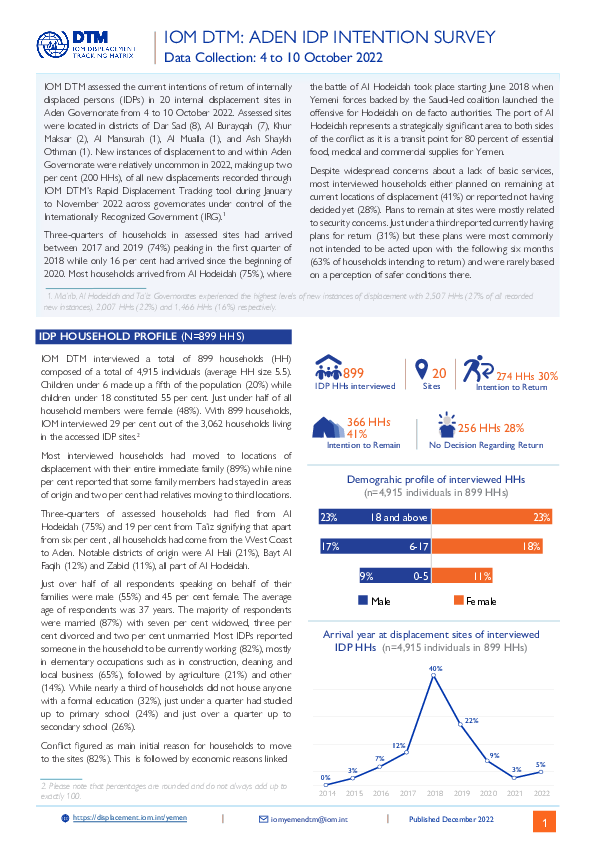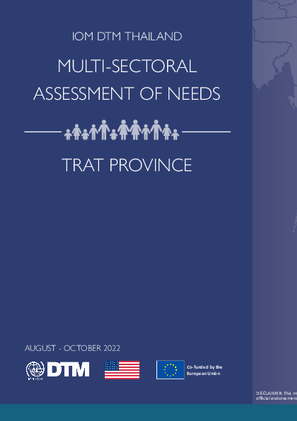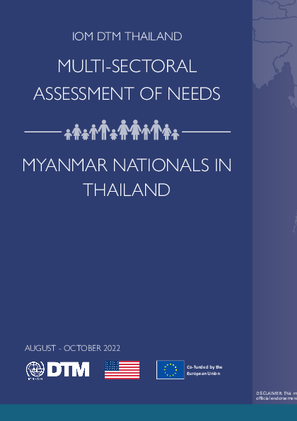-
Countries
-
Data and Analysis
-
Special Focus
-
Crisis Responses
Site Assessment

Contact
DTM Yemen, iomyemendtm@iom.int
Language
English
Location
Yemen
Period Covered
Oct 04 2022
Oct 10 2022
Activity
- Survey
- Return Intention
- Mobility Tracking
- Site Assessment
IOM DTM assessed the current intentions of return of internally displaced persons (IDPs) in 20 internal displacement sites in Aden Governorate from 4 to 10 October 2022. Assessed sites were located in districts of Dar Sad (8), Al Burayqah (7), Khur Maksar (2), Al Mansurah (1), Al Mualla (1), and Ash Shaykh Othman (1). New instances of displacement to and within Aden Governorate were relatively uncommon in 2022, making up two per cent (200 HHs), of all new displacements recorded through IOM DTM’s Rapid Displacement Tracking tool during January to November 2022 across governorates under control of the Internationally Recognized Government (IRG).
Three-quarters of households in assessed sites had arrived between 2017 and 2019 (74%) peaking in the first quarter of 2018 while only 16 per cent had arrived since the beginning of 2020. Most households arrived from Al Hodeidah (75%), where the battle of Al Hodeidah took place starting June 2018 when Yemeni forces backed by the Saudi-led coalition launched the offensive for Hodeidah on de facto authorities. The port of Al Hodeidah represents a strategically significant area to both sides of the conflict as it is a transit point for 80 percent of essential food, medical and commercial supplies for Yemen.

Contact
DTMThailand@iom.int
Language
English
Location
Thailand
Period Covered
Aug 22 2022
Oct 23 2022
Activity
- Survey
- Site Assessment
This factsheet aims to provide a snapshot of multi-sectoral conditions, needs and challenges among the migrant population in Trat province, Thailand as captured between August to October 2022 by IOM’s Displacement Tracking Matrix’s (DTM) multi-sectoral assessment of needs. The purpose of this assessment is to provide detailed multi- and inter-sectoral analysis of the magnitude and severity of needs among migrant populations, identify vulnerable population groups and geographic areas with the most acute needs, inform development assistance planning and relevant Sustainable Development Goals (SDGs) targets, and provide sectoral and inter-sectoral baselines for future assessments.
The tool was developed with the collaboration of IOM’s Displacement Tracking Matrix (DTM) and various sectoral IOM units, including Labour Mobility and Social Inclusion (LMI), Migration Health Division (MHD), Migrant Assistance and Counter-Trafficking Unit (MACTU), and the Emergency and Post-Crisis unit (EPC), among others. The survey is a household-level survey, but also includes sections for which the respondent had to answer on behalf of every member of their household (for example, the ages of all members of the household). DTM surveyed a representative sample randomly selected within the population of interest, which included Myanmar and Cambodian migrants in Thailand. DTM aimed for a 50:50 balance between female and male respondents. Answers from 2,318 respondents were analyzed. Counting all respondents and their household members, 5,760 individuals are represented by the assessment.

Contact
DTMThailand@iom.int
Language
English
Location
Thailand
Period Covered
Aug 22 2022
Oct 23 2022
Activity
- Survey
- Site Assessment
This factsheet aims to provide a snapshot of multi-sectoral conditions, needs and challenges among the migrant population in Tak province, Thailand as captured between August to October 2022 by IOM’s Displacement Tracking Matrix’s (DTM) multi-sectoral assessment of needs. The purpose of this assessment is to provide detailed multi- and inter-sectoral analysis of the magnitude and severity of needs among migrant populations, identify vulnerable population groups and geographic areas with the most acute needs, inform development assistance planning and relevant Sustainable Development Goals (SDGs) targets, and provide sectoral and inter-sectoral baselines for future assessments.
The tool was developed with the collaboration of IOM’s Displacement Tracking Matrix (DTM) and various sectoral IOM units, including Labour Mobility and Social Inclusion (LMI), Migration Health Division (MHD), Migrant Assistance and Counter-Trafficking Unit (MACTU), and the Emergency and Post-Crisis unit (EPC), among others. The survey is a household-level survey, but also includes sections for which the respondent had to answer on behalf of every member of their household (for example, the ages of all members of the household). DTM surveyed a representative sample randomly selected within the population of interest, which included Myanmar and Cambodian migrants in Thailand. DTM aimed for a 50:50 balance between female and male respondents. Answers from 2,318 respondents were analyzed. Counting all respondents and their household members, 5,760 individuals are represented by the assessment.

Contact
DTMThailand@iom.int
Language
English
Location
Thailand
Period Covered
Aug 22 2022
Oct 23 2022
Activity
- Survey
- Site Assessment
This factsheet aims to provide a snapshot of multi-sectoral conditions, needs and challenges among the migrant population in Rayong province, Thailand as captured between August to October 2022 by IOM’s Displacement Tracking Matrix’s (DTM) multi-sectoral assessment of needs. The purpose of this assessment is to provide detailed multi- and inter-sectoral analysis of the magnitude and severity of needs among migrant populations, identify vulnerable population groups and geographic areas with the most acute needs, inform development assistance planning and relevant Sustainable Development Goals (SDGs) targets, and provide sectoral and inter-sectoral baselines for future assessments.
The tool was developed with the collaboration of IOM’s Displacement Tracking Matrix (DTM) and various sectoral IOM units, including Labour Mobility and Social Inclusion (LMI), Migration Health Division (MHD), Migrant Assistance and Counter-Trafficking Unit (MACTU), and the Emergency and Post-Crisis unit (EPC), among others. The survey is a household-level survey, but also includes sections for which the respondent had to answer on behalf of every member of their household (for example, the ages of all members of the household). DTM surveyed a representative sample randomly selected within the population of interest, which included Myanmar and Cambodian migrants in Thailand. DTM aimed for a 50:50 balance between female and male respondents. Answers from 2,318 respondents were analyzed. Counting all respondents and their household members, 5,760 individuals are represented by the assessment.

Contact
DTMThailand@iom.int
Language
English
Location
Thailand
Period Covered
Aug 22 2022
Oct 23 2022
Activity
- Survey
- Site Assessment
This factsheet aims to provide a snapshot of multi-sectoral conditions, needs and challenges among the migrant population in Thailand as captured between August to October 2022 by IOM’s Displacement Tracking Matrix’s (DTM) multi-sectoral assessment of needs. The purpose of this assessment is to provide detailed multi- and inter-sectoral analysis of the magnitude and severity of needs among migrant populations, identify vulnerable population groups and geographic areas with the most acute needs, inform development assistance planning and relevant Sustainable Development Goals (SDGs) targets, and provide sectoral and inter-sectoral baselines for future assessments.
The tool was developed with the collaboration of IOM’s Displacement Tracking Matrix (DTM) and various sectoral IOM units, including Labour Mobility and Social Inclusion (LMI), Migration Health Division (MHD), Migrant Assistance and Counter-Trafficking Unit (MACTU), and the Emergency and Post-Crisis unit (EPC), among others. The survey is a household-level survey, but also includes sections for which the respondent had to answer on behalf of every member of their household (for example, the ages of all members of the household). DTM surveyed a representative sample randomly selected within the population of interest, which included Myanmar and Cambodian migrants in Thailand. DTM aimed for a 50:50 balance between female and male respondents. Answers from 2,318 respondents were analyzed. Counting all respondents and their household members, 5,760 individuals are represented by the assessment.

Contact
DTMThailand@iom.int
Language
English
Location
Thailand
Period Covered
Aug 22 2022
Oct 23 2022
Activity
- Survey
- Site Assessment
This factsheet aims to provide a snapshot of multi-sectoral conditions, needs and challenges among the Myanmar migrant population in Thailand as captured between August to October 2022 by IOM’s Displacement Tracking Matrix’s (DTM) multi-sectoral assessment of needs. The purpose of this assessment is to provide detailed multi- and inter-sectoral analysis of the magnitude and severity of needs among migrant populations, identify vulnerable population groups and geographic areas with the most acute needs, inform development assistance planning and relevant Sustainable Development Goals (SDGs) targets, and provide sectoral and inter-sectoral baselines for future assessments.
The tool was developed with the collaboration of IOM’s Displacement Tracking Matrix (DTM) and various sectoral IOM units, including Labour Mobility and Social Inclusion (LMI), Migration Health Division (MHD), Migrant Assistance and Counter-Trafficking Unit (MACTU), and the Emergency and Post-Crisis unit (EPC), among others. The survey is a household-level survey, but also includes sections for which the respondent had to answer on behalf of every member of their household (for example, the ages of all members of the household). DTM surveyed a representative sample randomly selected within the population of interest, which included Myanmar and Cambodian migrants in Thailand. DTM aimed for a 50:50 balance between female and male respondents. Answers from 2,318 respondents were analyzed. Counting all respondents and their household members, 5,760 individuals are represented by the assessment.

Contact
DTMThailand@iom.int
Language
English
Location
Thailand
Period Covered
Aug 22 2022
Oct 23 2022
Activity
- Survey
- Site Assessment
This factsheet aims to provide a snapshot of multi-sectoral conditions, needs and challenges among the migrant population in Chanthaburi province, Thailand as captured between August to October 2022 by IOM’s Displacement Tracking Matrix’s (DTM) multi-sectoral assessment of needs. The purpose of this assessment is to provide detailed multi- and inter-sectoral analysis of the magnitude and severity of needs among migrant populations, identify vulnerable population groups and geographic areas with the most acute needs, inform development assistance planning and relevant Sustainable Development Goals (SDGs) targets, and provide sectoral and inter-sectoral baselines for future assessments.
The tool was developed with the collaboration of IOM’s Displacement Tracking Matrix (DTM) and various sectoral IOM units, including Labour Mobility and Social Inclusion (LMI), Migration Health Division (MHD), Migrant Assistance and Counter-Trafficking Unit (MACTU), and the Emergency and Post-Crisis unit (EPC), among others. The survey is a household-level survey, but also includes sections for which the respondent had to answer on behalf of every member of their household (for example, the ages of all members of the household). DTM surveyed a representative sample randomly selected within the population of interest, which included Myanmar and Cambodian migrants in Thailand. DTM aimed for a 50:50 balance between female and male respondents. Answers from 2,318 respondents were analyzed. Counting all respondents and their household members, 5,760 individuals are represented by the assessment.

Contact
DTMThailand@iom.int
Language
English
Location
Thailand
Period Covered
Aug 22 2022
Oct 23 2022
Activity
- Survey
- Site Assessment
This factsheet aims to provide a snapshot of multi-sectoral conditions, needs and challenges among the Cambodian migrant population in Thailand as captured between August to October 2022 by IOM’s Displacement Tracking Matrix’s (DTM) multi-sectoral assessment of needs. The purpose of this assessment is to provide detailed multi- and inter-sectoral analysis of the magnitude and severity of needs among migrant populations, identify vulnerable population groups and geographic areas with the most acute needs, inform development assistance planning and relevant Sustainable Development Goals (SDGs) targets, and provide sectoral and inter-sectoral baselines for future assessments.
The tool was developed with the collaboration of IOM’s Displacement Tracking Matrix (DTM) and various sectoral IOM units, including Labour Mobility and Social Inclusion (LMI), Migration Health Division (MHD), Migrant Assistance and Counter-Trafficking Unit (MACTU), and the Emergency and Post-Crisis unit (EPC), among others. The survey is a household-level survey, but also includes sections for which the respondent had to answer on behalf of every member of their household (for example, the ages of all members of the household). DTM surveyed a representative sample randomly selected within the population of interest, which included Myanmar and Cambodian migrants in Thailand. DTM aimed for a 50:50 balance between female and male respondents. Answers from 2,318 respondents were analyzed. Counting all respondents and their household members, 5,760 individuals are represented by the assessment.

Contact
DTM Ethiopia, DTMEthiopia@iom.int
Language
English
Location
Ethiopia
Period Covered
Aug 08 2022
Sep 17 2022
Activity
- Mobility Tracking
- Site Assessment
- Village Assessment
In order to capture the displacement and return dynamics in Ethiopia, DTM Ethiopia's National Displacement Report combines findings from its Site Assessment (SA) in Section 1 and findings from the Village Assessment Survey (VAS) in Section 2. The Site Assessment tracks the number of internally displaced persons (IDPs), while the Village Assessment Survey tracks the number of IDPs who are returning or have returned to their communities.
According to data collected through the Site Assessment round 31 in August and September 2022, 2.73 million IDPs (517,201 households) were internally displaced across 2,200 accessible sites in Ethiopia. This reflects a +0.43% increase compared to the previous round of data collection in June and July 2022. Due to operational constraints, the figure for Tigray region is not included in the national total.
According to the data collected through the Village Assessment Survey round 14 between August and September 2022, there were an estimated 1.88 million returning IDPs (437,077 households) across 1,554 villages in Ethiopia. This represents a -6% decrease compared to the previous round of data collection in June and July 2022. Due to operational constraints, the figure for Tigray region is not included in the national total.
Pagination
- Previous page
- Page 31
- Next page
